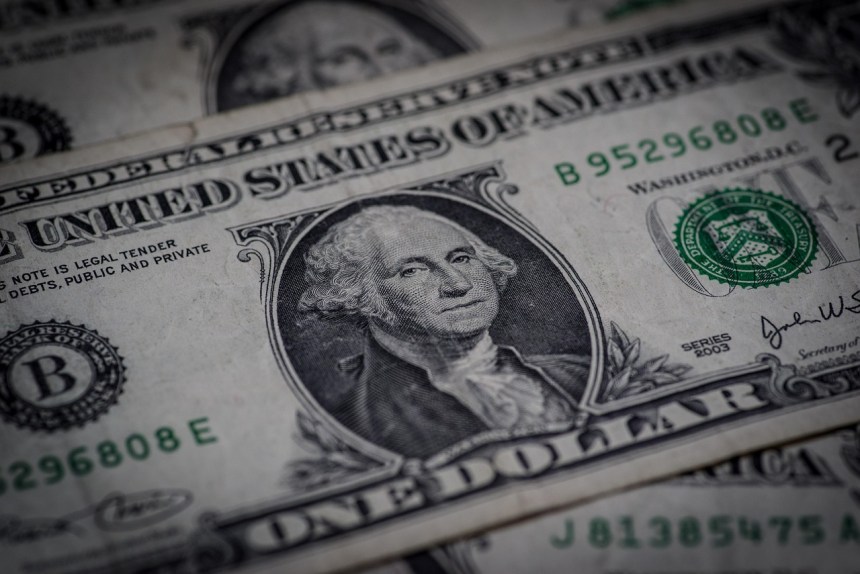Reason to trust

How Our News is Made
Strict editorial policy that focuses on accuracy, relevance, and impartiality
Ad discliamer
Morbi pretium leo et nisl aliquam mollis. Quisque arcu lorem, ultricies quis pellentesque nec, ullamcorper eu odio.
Conventional crypto wisdom has traditionally painted stablecoins as a potential threat to the U.S. dollar’s hegemony: digital upstarts set to erode the greenback’s status as the world’s reserve currency by enabling seamless and borderless alternatives. After all, if you can peg a token to any fiat or asset, why stick with the dollar? And at least with stablecoins, we’re instantly alerted the moment another billion dollars is printed out of thin air. The Federal Reserve is less transparent
Yet, in a twist that encapsulates the “4D chess” that Trump supporters credit the current U.S. administration with playing, the passage of the Genius Act may have had a side-effect that, amidst all the political wrangling and earnest analysis, has been largely overlooked. Rather than accelerating the dollar’s obsolescence, the Act might actually be supercharging its dominance, turning stablecoins into unwitting ambassadors for American financial might.
Far from weakening the buck, the legislation could position the dollar as the de facto global unit of account for the exploding stablecoin ecosystem, with ripple effects that could echo through international trade for years. While the Genius Act had little to do with Donald Trump short of bearing his signature, it’s characteristic of the unpredictability that is synonymous with his style of government. Everyone predicted that the Act would legitimize stablecoins. Few predicted that it would form a Trojan horse for future-proofing the U.S. dollar.
Fortifying the Greenback
Not everyone was enamored when the GENIUS Act cleared the Senate a few weeks ago, with skeptics fretting that formalizing stablecoin issuance might invite competition from euro-pegged or yuan-backed rivals, chipping away at USD supremacy. But peel back the layers, and the reality is far more nuanced – and far more bullish for the dollar. By establishing clear, U.S.-centric guardrails for stablecoin issuers, the Act has effectively channeled the sector’s explosive growth straight into dollar-denominated channels.
Given that the Act heavily favors U.S. companies with funds held in U.S. banks and reserves that include U.S. Treasuries, there’s a whole lot of U.S in the mix. It doesn’t prohibit regulated entities from issuing stablecoins pegged to other currencies, but make no mistake: this is an American bill designed to ensure the U.S. dollar dominates onchain just as it does in traditional finance. It’s a pathway for responsibly issuing digital dollars that are proudly made in America.
As Andrei Grachev, Managing Partner at DWF Labs, astutely observes: “Framing stablecoins as a tool to maintain dollar prominence could be said to be a practical, and not just a competitive move. For instance, last year, global stablecoin volume reached an estimated $27.6 trillion, surpassing both Visa and Mastercard combined. And despite moves by non‑USD issuers, over 99 % remain USD‑denominated. As Asia and the UAE scale onchain finance, dollar‑backed tokens will anchor global liquidity which looks like a reinforcement, instead of an undermining, of the greenback’s reserve status.”
He’s got a point. In a world where stablecoins are morphing from hedging tools into foundational infrastructure for payments, remittances, and AI-driven economies, the GENIUS Act ensures that the lion’s share of this innovation orbits the USD. Issuers must back their tokens with high-quality reserves like U.S. Treasuries or cash equivalents, creating a virtuous cycle: more stablecoins mean more demand for dollar assets, which in turn bolsters Treasury yields and reinforces the dollar’s appeal as a safe haven. Rather than erosion, it’s entrenchment.
How the GENIUS Act Locks in Dollar Dominance
At its core, the GENIUS Act demystifies stablecoins by classifying “payment stablecoins” as USD-pegged digital assets, mandating full reserves and regular audits – plus the obligatory robust compliance. It invites institutional heavyweights to the table with the promise that if they play by the rules, they won’t get burned. Banks and fintechs that once viewed stables as regulatory minefields are now diving in, confident they won’t get blindsided by enforcement actions.
The result is a surge in USD-backed issuance that’s making the dollar the lingua franca of onchain finance. Cross-border payments, long plagued by high fees and delays, are just one industry getting a dollar-fueled upgrade. It’s not that remittances from the U.S. to Latin America couldn’t be sent in seconds via USDC prior to the GENIUS Act; it’s just that now enterprises have the green-light to proceed, rather than constantly looking over their shoulder at lurking regulatory agencies.
Rather than displacing the dollar, the Act looks poised to extend its reach into digital realms where it previously had none. Regions like Asia and the Middle East, keen to burnish their credentials as tech hubs, are adopting these tools en masse – but overwhelmingly in USD form since the dollar has been the primary stablecoin-pegged currency since day one. The network effects are real.
The Counterpoint
Critics counter that the Act could backfire by sparking a stablecoin arms race, with the EU’s MiCA framework or China’s digital yuan luring issuers away. It’s a valid point, but the data suggests otherwise. Non-USD stables like EURT or CNHC remain niche players, comprising less than 1% of the market, while USD variants thrive because they tap into the dollar’s network effects of vast liquidity pools and integration with U.S.-dominated financial systems. By codifying these advantages, the GENIUS Act is raising the bar for all challengers.
That’s not to say that fiat-backed alternatives to USD stablecoins won’t emerge – they undoubtedly will, and may even gain market share on dollar-pegged stables if someone like China creates a yuan-backed token and gets other BRICS nations to support it. But there’s no realistic timeline in which the USD’s stablecoin dominance is toppled. It is to stables what BTC is to crypto.
Dollars by Data
Onchain data paints a vivid picture of USD reinforcement, not retreat. Total stablecoin market cap has ballooned to $258 billion since the Act’s passage, with USD-denominated tokens claiming over 99% of that pie. Tether’s USDT holds court at $163 billion, while Circle’s USDC has jumped from $44 billion in January to $63 billion – a 43% leap that’s no coincidence. More than just milestones, these benchmarks are evidence of institutional buy-in, from BlackRock’s tokenized funds to PayPal’s stablecoin expansions, all hitching their wagons to the dollar star.
This growth will inevitably cascade into real-world industries. Indeed, speaking of the real world, stablecoins are fueling a $25 billion RWA sector, where everything from Treasuries to real estate is tokenized – and naturally USD-denominated stables underpin most of it. For emerging markets battling inflation, dollar stables offer a lifeline, allowing citizens to store value without forex hurdles. In DeFi, USD pegs provide the stable base for lending, borrowing, and yield farming. It’s a feedback loop in which more adoption drives more reserve holdings in dollar assets, which strengthens the currency’s reserve status and attracts even more users.
Of course, no policy is flawless. Detractors warn that over-reliance on USD stables could amplify systemic risks if a major issuer falters, or that it entrenches U.S. monetary policy in ways that irk geopolitically. There’s merit there since shadow banking parallels loom large. Yet, the Act’s safeguards, like priority repayments for holders and stringent reserves, tilt the scales toward resilience. In a multipolar world, this isn’t about isolation but smart power projection through financial innovation.
What does this mean for the dollar’s future? In essence, elevation. As stablecoins scale to potentially $500 billion by 2028, they’ll carry the USD into uncharted territories from AI economies to tokenized supply chains, solidifying its role as the ultimate unit of account. It turns out the future of finance may be driven by a major player from its past.
Image by Michael Kauer from Pixabay

















